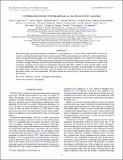CONFIRMATION OF HOT JUPITER KEPLER-41b VIA PHASE CURVE ANALYSIS
Author(s)
Quintana, Elisa V.; Rowe, Jason F.; Barclay, Thomas; Howell, Steve B.; Ciardi, David R.; Demory, Brice-Olivier; Caldwell, Douglas A.; Borucki, William J.; Christiansen, Jessie L.; Jenkins, Jon M.; Klaus, Todd C.; Fulton, Benjamin J.; Morris, Robert L.; Sanderfer, Dwight T.; Shporer, Avi; Smith, Jeffrey C.; Still, Martin; Thompson, Susan E.; ... Show more Show less
DownloadQuintana-2013-CONFIRMATION OF HOT.pdf (6.092Mb)
PUBLISHER_POLICY
Publisher Policy
Article is made available in accordance with the publisher's policy and may be subject to US copyright law. Please refer to the publisher's site for terms of use.
Terms of use
Metadata
Show full item recordAbstract
We present high precision photometry of Kepler-41, a giant planet in a 1.86 day orbit around a G6V star that was recently confirmed through radial velocity measurements. We have developed a new method to confirm giant planets solely from the photometric light curve, and we apply this method herein to Kepler-41 to establish the validity of this technique. We generate a full phase photometric model by including the primary and secondary transits, ellipsoidal variations, Doppler beaming, and reflected/emitted light from the planet. Third light contamination scenarios that can mimic a planetary transit signal are simulated by injecting a full range of dilution values into the model, and we re-fit each diluted light curve model to the light curve. The resulting constraints on the maximum occultation depth and stellar density combined with stellar evolution models rules out stellar blends and provides a measurement of the planet's mass, size, and temperature. We expect about two dozen Kepler giant planets can be confirmed via this method.
Date issued
2013-04Department
Massachusetts Institute of Technology. Department of Earth, Atmospheric, and Planetary SciencesJournal
Astrophysical Journal
Publisher
IOP Publishing
Citation
Quintana, Elisa V., Jason F. Rowe, Thomas Barclay, Steve B. Howell, David R. Ciardi, Brice-Olivier Demory, Douglas A. Caldwell, et al. “CONFIRMATION OF HOT JUPITER KEPLER-41b VIA PHASE CURVE ANALYSIS.” The Astrophysical Journal 767, no. 2 (April 5, 2013): 137. © 2013 The American Astronomical Society
Version: Final published version
ISSN
0004-637X
1538-4357